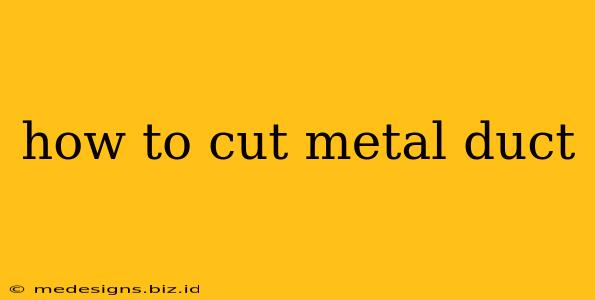Cutting metal ductwork might seem daunting, but with the right tools and techniques, it's a manageable task. Whether you're a seasoned professional or a DIY enthusiast tackling a home improvement project, this guide will walk you through the process, ensuring clean, safe, and efficient cuts every time.
Choosing the Right Tools for the Job
The key to successful metal duct cutting lies in selecting the appropriate tools. The best tool depends on the type of metal and the thickness of the duct. Here's a breakdown:
For Thinner Gauge Metal (Under 24 Gauge):
- Aviation Snips: These versatile snips are excellent for making straight cuts, curved cuts, and intricate shapes in thinner gauge metal. They're lightweight and easy to maneuver. Different types of aviation snips (left-cut, right-cut, straight) allow for various cutting angles.
- Tin Snips: Similar to aviation snips, but generally less expensive and suitable for simpler cuts.
- Rotary Cut-Off Tool (with metal cutting blade): While powerful, use caution with this method as it can create sparks and require safety glasses and proper ventilation. It's ideal for quick, straight cuts on thinner material.
For Thicker Gauge Metal (24 Gauge and Above):
- Reciprocating Saw (with metal-cutting blade): This is a powerful option for thicker metal ductwork. Ensure you use a blade specifically designed for metal to avoid damaging the saw.
- Circular Saw (with metal-cutting blade): Another powerful option for straight cuts, especially in thicker materials. Again, a metal-cutting blade is essential, and safety precautions (eye protection, hearing protection) are critical.
- Jigsaw (with metal-cutting blade): Provides more control for curved cuts in thicker materials, but it can be slower than other power tools.
Essential Accessories:
Regardless of the cutting method, these are crucial:
- Safety Glasses: Protect your eyes from flying debris and sparks.
- Work Gloves: Protect your hands from sharp edges and potential cuts.
- Metal File or Grinder: Smooth out rough edges after cutting to prevent injuries.
- Measuring Tape and Pencil: Precise measurements are essential for accurate cuts.
- Safety Mask/Respirator (for thicker metals and power tools): Protect yourself from dust and fumes.
Cutting Techniques: Step-by-Step
After selecting your tools, follow these steps for a clean and precise cut:
- Measure Twice, Cut Once: Accurate measurement is crucial. Double-check your measurements before making any cuts.
- Secure the Duct: Use clamps or a vise to hold the duct firmly in place. This prevents movement and ensures a straight cut.
- Make the Cut: Use your chosen tool and carefully follow the marked line. Maintain a steady pace and avoid forcing the tool.
- Deburr and Smooth: Use a metal file, grinder, or sandpaper to smooth out any sharp edges or burrs created during the cutting process. This is vital for safety and to prevent damage to the ductwork's lining.
- Inspect your Cut: Ensure the cut is clean and straight. If needed, make minor adjustments with a file.
Safety First!
Working with metal and power tools presents inherent risks. Always prioritize safety:
- Wear appropriate safety gear: This includes safety glasses, work gloves, and a respirator (when necessary).
- Use the right tool for the job: Don't attempt to cut thick metal with tools designed for thin materials.
- Maintain a firm grip: Avoid accidental slips or drops that could cause injury.
- Work in a well-ventilated area: This is particularly important when using power tools that generate sparks or fumes.
- Be aware of surroundings: Keep a clear workspace to prevent tripping or accidents.
Beyond the Basics: Specialized Techniques
For more complex projects, consider these advanced techniques:
- Using a Hole Saw: Ideal for creating perfectly round holes in the ductwork.
- Nibbling: A technique involving using a special tool to make small, incremental cuts, allowing for precise shaping and curves.
By following these tips and choosing the right tools, you can confidently tackle your next metal duct cutting project. Remember, safety always comes first! Happy cutting!
